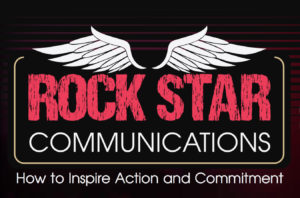 Even highly intelligent, well-educated, and ambitious executives can find themselves at a loss when called on to deliver a powerful presentation. The good news is, even if you’re not a born speaker, you can learn how to inspire action and commitment. I share the ROCK Star Principles one shy engineer used – and you can also use too – to become a ROCK Star communicator in the business world.
Even highly intelligent, well-educated, and ambitious executives can find themselves at a loss when called on to deliver a powerful presentation. The good news is, even if you’re not a born speaker, you can learn how to inspire action and commitment. I share the ROCK Star Principles one shy engineer used – and you can also use too – to become a ROCK Star communicator in the business world.
Imagine yourself in the front row of a ballroom at a convention. Sitting with you are sales professionals from all over the world. This was a software company’s challenging January sales meeting.
That company had recently bought a competitor, and 40% of the sales professionals had nothing to do with the decision. The opening speaker, who is the company’s president, was challenged with getting everyone to know they are working for the right company, at the right time, that the company’s strategy is sound, and that they can have a great career with us. He is an engineer, a brilliant leader, and rather shy. He is not a bad speaker; for this meeting, however, he knows he needs to become the corporate Rock Star.”
I share the third ROCK Star Principle our shy engineer used and that you can also use too to become a ROCK Star communicator in the business world.
Rock Star Principle 1: R = Rehearse
If you missed my previous article on rehearsing for your presentation, you can read it here.
Rock Star Principle 2: O = Opening
If you missed my previous article on opening your presentation, you can read it here.
(NEW) Rock Star Principle 3: C = Core Message
Each Rock tour has a theme.
Know your central theme and core message. Your opening remarks must logically transition into the main message. The body will prove your central idea. After his opening line, our executive answered the audience’s unspoken questions. Why the decision was made, what would it mean to them, and why was he the best leader?
The person behind the position is the person they would fight for, work long hours for, and whose corporate strategy gives them confidence. We respect the position; we get emotionally connected to the person. It is not only what you say that communicates your message. It is also the subtext, what you aren’t saying outright. They are thinking, “Our corporate strategy must be good. Our president has been studying strategy since he was 14.”
Rock Star communicators also realize that in order to inspire action, you need to appeal to the audience’s rational self-interest. People make decisions for their reasons, not yours. They need to understand what is in it for them. This is part three in a four-part series. Catch up on part one, which explains why and how to rehearse. In part two, I explain why and how to capture your audience’s attention from your first words. Part four covers closing your presentation in a way that supports your core message.
Enjoy this replay of my recent web event, How to Steal the Show Every Time You Speak:
![]() If you want to become a great speaker easily, conveniently, and quickly, FrippVT can help. Enjoy three free chapters on Stories, Openings, and Sales: http://frippvt.com
If you want to become a great speaker easily, conveniently, and quickly, FrippVT can help. Enjoy three free chapters on Stories, Openings, and Sales: http://frippvt.com
“I wanted a super bowl-quality coach, and I was lucky to be introduced to Patricia Fripp. Her help in coaching and scripting was world class. With Patricia Fripp on your team, you can go places.”
– Don Yaeger, Long-Time Associate Editor for Sports Illustrated magazine, Award-Winning Keynote Speaker, New York Times Best-Selling Author
Executive Speech Coach and Hall of Fame Keynote Speaker, Patricia Fripp works with individuals and companies who realize that powerful, persuasive presentation skills give them a competitive
